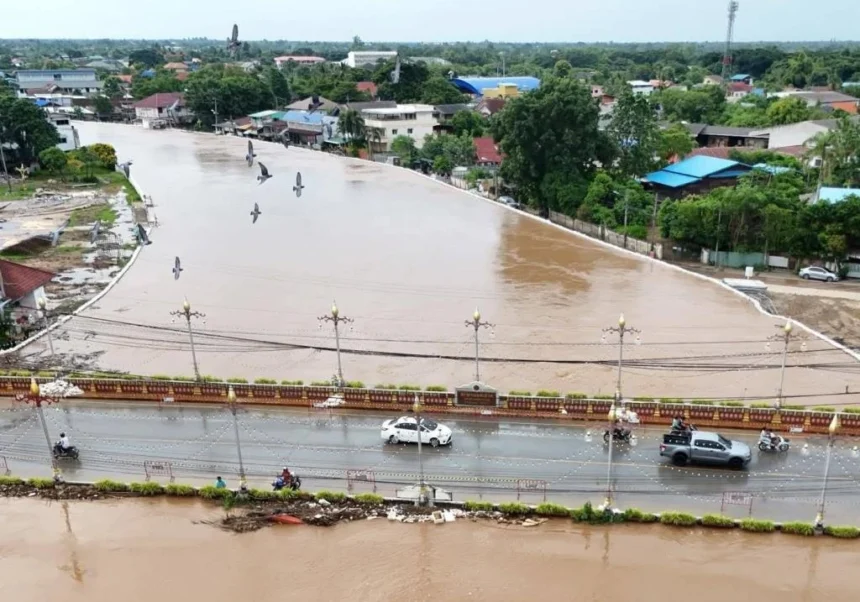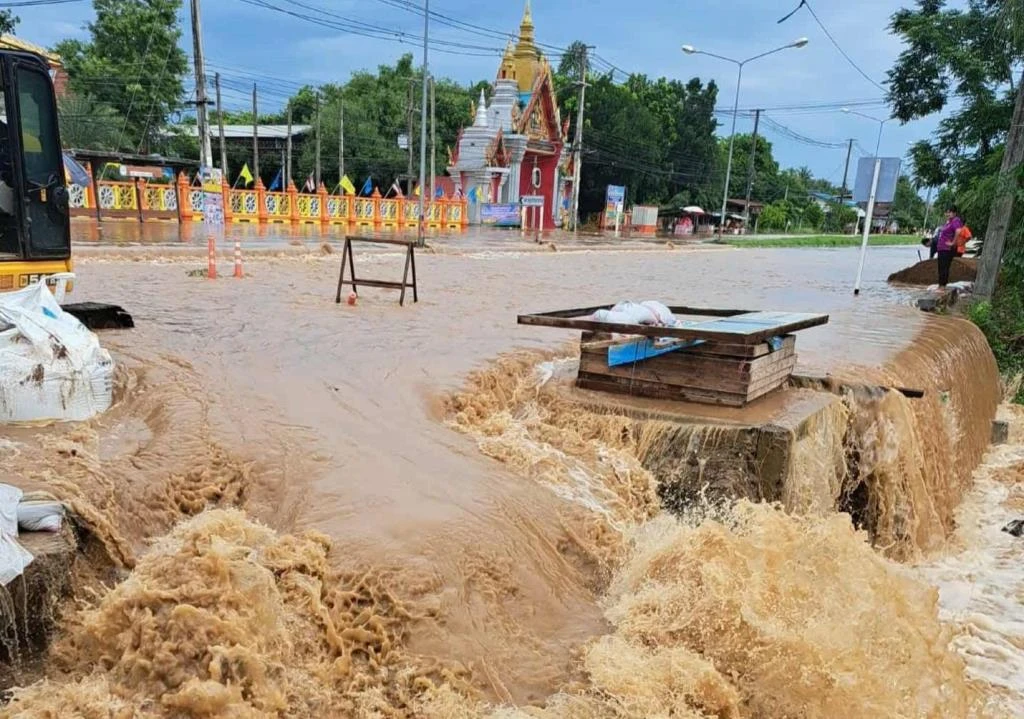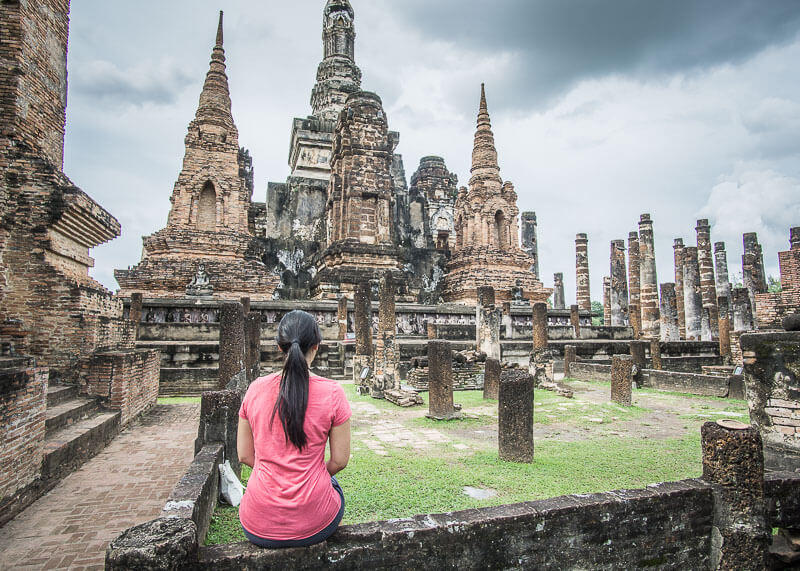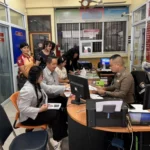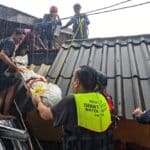SUKHOTHAI – The historic City of Sukhothai faces another wave of hardship, after heavy rain from Tropical Storm Kajiki caused the Yom River to swell beyond critical levels since the area of Si Samrong. The riverbanks near Wat Kuhasuwannaram and behind Wat Pak Khae have broken, sending floodwater rushing into several parts of Sukhothai city.
On August 28, 2568, Mr. Nopparit Sirikosol, Governor of Sukhothai, shared an update on the Yom River’s flooding. The impact of the Kajiki storm has brought downpours across the province.
Water from Phrae has flowed into Sukhothai since the night of August 27, with levels at station Y33 in Si Samrong district hitting 10 metres and water flow reaching 566.80 cubic metres per second.
By 4:00 am on August 28, the gauge in front of the governor’s residence (Y4) showed 7.56 metres with a flow of 401.50 cubic metres per second. Flooding has already affected multiple neighbourhoods. It began after the riverbanks gave way at Wat Kuhasuwannaram in Ban Thani and behind Wat Pak Khae in Moo 4, Pak Khae.
Water has spilled over main roads, including the outer Pak Khae road between villages 2 and 4, forcing authorities to close more than 200 metres of road near Wat Pak Khae due to deep flooding on both sides.
Affected areas of Sukhothai include:
- Villages 4, 14, and 24 in Mae Sin subdistrict, where farmland has flooded, and parts of Si Satchanalai subdistrict, where erosion threatens homes.
- The area near the Kuha Suwannaram community (Fuengfha point), where the river has slipped through the floodwall. About 50 centimetres of water is inside, flooding roughly 300 households.
- Village 4, Pak Khae subdistrict, behind Wat Pak Khae, where water has gone over the river barrier.
- Village 1, Yang Sai subdistrict in Sukhothai city, where water seeps through sandbags.
- Behind the Chang Beer Hall, Wang Hin community in Sukhothai city, where water has topped the Yom River barrier.
- Ramae Ya Bridge in Ramae Ya community, Sukhothai city, is closed.
- Village 1, Khlong Yang subdistrict, Sawankhalok district, where the Yom-Nan canal bank has broken, letting water into parts of Ban Khlong Poo farmland.
- Village 8, Khlong Maplap subdistrict, Si Nakhon district, with about 400 metres of canal overflowing.
- Village 5, Si Nakhon subdistrict, Si Nakhon district, with water beginning to erode the embankments.
- Village 6, Wang Yai subdistrict, Si Samrong district, where water passes under Siripanyarat bridge.
- The bridge near Wat Srinikorn Tharam in Khlong Tan subdistrict, Si Samrong, is closed.
- Villages 1 and 2, Khlong Yang subdistrict, Sawankhalok, where floodwater is starting to overflow into the Bung Pak Krathum embankment.
Emergency teams are monitoring the situation closely and working to assist affected residents and travellers. The province continues to provide updates as flood levels change.
About Sukhothai Thailand
Sukhothai, which translates to “Dawn of Happiness,” is a city with deep roots in Thailand’s past, standing as the original capital of the Kingdom of Siam from the 13th century. Found in northern Thailand, about 400 kilometres from Bangkok, it attracts visitors with its ancient ruins and proud role in shaping Thai culture.
Sukhothai Highlights
- Historical Importance: Established around 1238 by King Si Inthrathit, Sukhothai was the heart of the first unified Thai state. It saw the rise of Thai culture, art, and early government systems. During King Ramkhamhaeng’s rule from 1279 to 1298, the Thai script came to life and Theravada Buddhism became the main faith, marking a golden age for the city.
- Sukhothai Historical Park: Named a UNESCO World Heritage Site in 1991, this park stretches over 70 square kilometres and is home to around 200 ancient sites. Temples like Wat Mahathat and Wat Si Chum, with their towering seated Buddha, reflect the unique Sukhothai style, blending Khmer and Sri Lankan influences.
- Cultural Legacy: Sukhothai shaped Thai identity through graceful art, the creation of the Thai language script, and its approach to rulership, based on a caring and protective model.
- Present-Day Sukhothai: Today’s New Sukhothai sits 12 kilometres from the historic park. The town has a relaxed vibe, with friendly guesthouses, local markets, and festivals such as Loy Krathong, when people float candles on water. The festival is especially colourful when held at the historical park.
- Planning Your Visit: The park is easy to explore by bicycle. Key spots include Wat Mahathat, Wat Si Sawai, and Wat Sa Si. For the most comfortable weather, visit between November and February. Entry fees are usually between 100 and 150 THB per zone, with small extra charges for bikes or cars.
Current Insights
- Sukhothai continues to draw travellers who enjoy history, and recent posts on social media platforms such as X praise its peaceful atmosphere and rich culture. Some visitors suggest stopping by Si Satchanalai nearby for an even deeper look at the region’s history.
- The area has experienced some flooding in recent years, but tourism remains strong. Restoration efforts are ongoing to keep the ancient ruins in good shape.
Planning a visit or want current tips, travel details, or updates on local events? Let me know what you need and I’ll help you prepare your trip.




